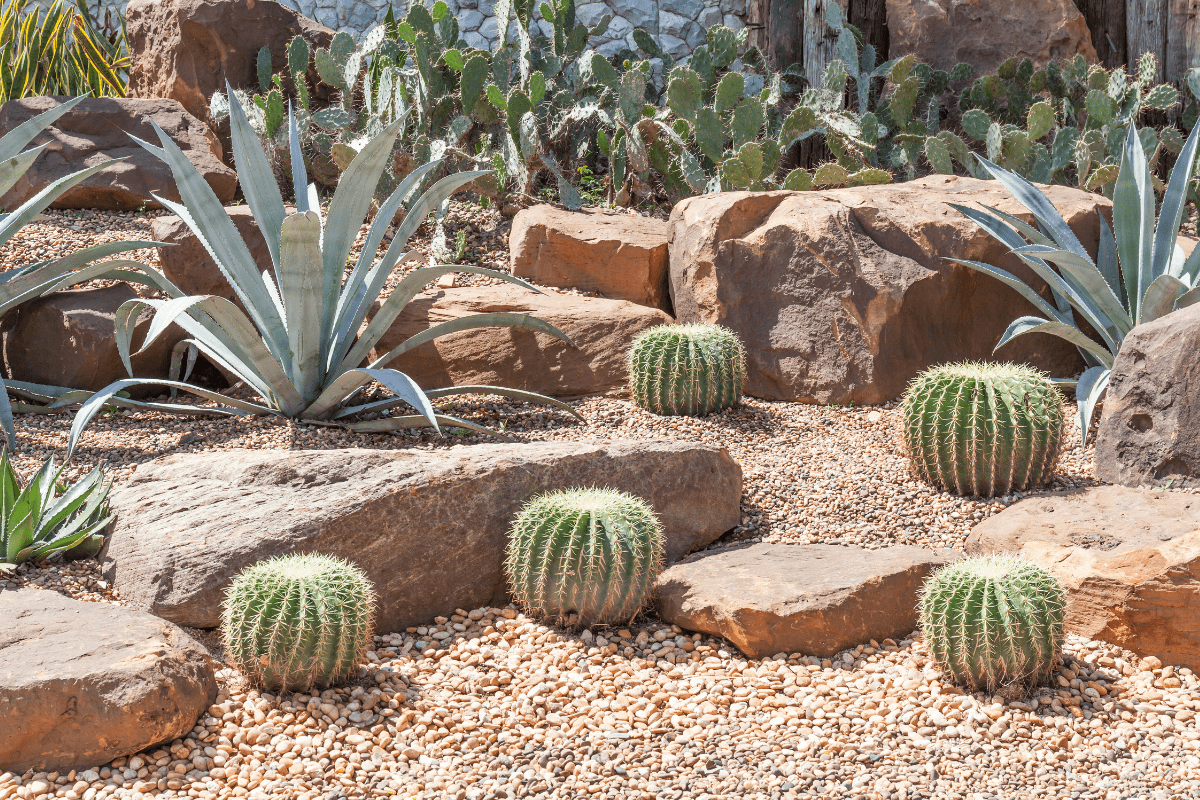Nevada might be famous for casino lights and desert wastelands, but the Silver State harbors some surprisingly lush secrets. From free 24-hour conservatories to sprawling desert demonstration gardens, these botanical oases prove that even America's driest state can bloom with unexpected beauty. Whether you're seeking Instagram-worthy flower displays or practical water-wise landscaping ideas, Nevada's gardens offer experiences that'll change how you think about desert living.
Southern Nevada's desert showpieces
The Las Vegas valley transforms its harsh Mojave Desert setting into three distinct botanical experiences that each interpret desert beauty differently. These aren't your typical manicured suburban gardens… they're living laboratories that prove stunning landscapes can thrive in one of Earth's most challenging environments.
Springs Preserve leads Nevada's conservation mission
Located at 333 South Valley View Boulevard, Springs Preserve represents Nevada's most comprehensive botanical experience across 180 acres of rescued desert plants. The facility operates Thursday through Monday from 9 AM to 4 PM, charging Nevada residents just $9.95 for adults while non-residents pay $18.95.
The preserve's crown jewel botanical garden showcases over 400 mature plants, many standing 30-plus feet tall after being transplanted from development sites around Las Vegas. Spring visitors witness barrel cacti and desert wildflowers creating explosions of color that rival any traditional garden, while the facility's 3.6 miles of trails wind through themed areas including Desert Gems Garden, Cactus Alley, and a surprisingly diverse Palm Garden featuring 10 species adapted to desert conditions.
The botanical garden section operates as a nationally accredited collection focused specifically on Mojave Desert plants. This isn't just pretty landscaping… it's serious conservation work that preserves genetic diversity of native species while teaching visitors practical applications for sustainable desert living.
Bellagio Conservatory offers free luxury gardens
Inside the Bellagio Hotel at 3600 Las Vegas Boulevard South, the Conservatory & Botanical Gardens provides one of Las Vegas's most visited free attractions. This 14,000-square-foot indoor wonderland remains open 24 hours daily except during brief transition periods when displays change five times annually.
Each seasonal transformation involves 140 horticulturists replacing thousands of living plants flown in from around the world. The Lunar New Year, Spring, Summer, Fall, and Winter displays create entirely different experiences throughout the year, with elaborate installations that combine living plants with artistic elements under a 50-foot glass ceiling.
Visit timing makes a huge difference here. Weekend crowds can make the space feel like a theme park, but early mornings before 10 AM or late nights after 11 PM offer peaceful experiences where you can actually appreciate the intricate details. Most visitors spend 20-45 minutes exploring, though photography enthusiasts often linger longer during optimal lighting conditions.
Ethel M combines chocolate with cacti
Henderson's Ethel M Botanical Cactus Garden provides Nevada's largest cactus collection across three acres at 2 Cactus Garden Drive. This free attraction combines botanical education with chocolate factory tours, operating daily from 8:30 AM to 6 PM.
The garden features over 350 species from the American Southwest, Australia, and South America, creating living displays that demonstrate the incredible diversity within desert plant families. March through April brings peak blooming season when many cacti produce surprisingly delicate flowers in yellows, pinks, and reds that contrast dramatically with their spiny exteriors.
The garden truly transforms during its famous holiday light display from November through January, when over one million lights illuminate the cacti and desert plants. This creates one of Southern Nevada's most photographed seasonal attractions, proving that desert gardens can be just as magical as traditional holiday displays.
University gardens demonstrate practical possibilities
Nevada's university systems maintain botanical collections that serve dual purposes: education and community demonstration of what's actually possible in desert climates.
UNLV Extension teaches water-wise landscaping
The UNLV Extension Botanic Gardens at 8050 Paradise Road serves as Southern Nevada's premier demonstration site for sustainable desert landscaping. This seven-acre facility maintains approximately 4,500 plants representing over 1,000 species, all selected for adaptation to Mojave Desert conditions.
Open weekdays from 8 AM to 5 PM with free admission, the gardens are managed by more than 250 certified Master Gardeners who maintain themed demonstration areas. These aren't just pretty displays… they show homeowners practical applications for water-smart landscaping that complies with Southern Nevada Water Authority restrictions.
The facility proves that diverse, beautiful gardens can thrive on minimal water when proper plant selection and irrigation techniques are employed. Visitors see firsthand how deep irrigation systems encourage roots to reach 18-24 inches, while drip systems minimize water waste and strategic microclimates maximize plant survival.
UNLV campus pioneered desert xeriscaping
The Donald H. Baepler Xeric Garden on UNLV's main campus pioneered large-scale xeriscaping in Las Vegas when it opened in 1988. This 1.5-acre garden at the Marjorie Barrick Museum entrance showcases drought-tolerant plants from four North American deserts plus Mediterranean climates, Australia, and South America.
The garden's 9,000 square feet of paved pathways wind through collections of blue yucca, agave, eucalyptus, and creosote bush, with sandstone boulders from Mount Potosi providing natural sculptural elements. Biology and landscape architecture students use the space as a living laboratory, while the public enjoys free access during daylight hours.
This garden demonstrates how institutional landscaping can embrace rather than fight desert conditions. Instead of trying to recreate Eastern or European garden aesthetics, the design celebrates plants that actually thrive in Nevada's challenging climate.
Community Healing Garden provides memorial space
The Las Vegas Community Healing Garden at 1015 South Casino Center Boulevard represents a different kind of botanical space. This quarter-acre memorial was built by over 400 volunteers in just four days following the October 1, 2017 tragedy.
The garden's 58 memorial trees, one for each victim, surround an oak "Tree of Life" donated by Siegfried & Roy, while 1,278 tiles created by families, survivors, and community members line the Wall of Remembrance. Open daily with free admission, this contemplative space demonstrates how gardens serve purposes beyond beauty, providing communal healing through nature.
Gardens like this prove that botanical spaces can address community needs beyond recreation or education. They become gathering places for reflection, remembrance, and renewal that wouldn't be possible without the calming influence of living plants.
Northern Nevada embraces elevation advantages
Reno's higher elevation transforms Nevada's gardening possibilities, enabling plant collections that would be impossible in the scorching Mojave Desert around Las Vegas.
Wilbur D. May Arboretum showcases diversity
Wilbur D. May Arboretum & Botanical Garden within Rancho San Rafael Regional Park showcases what becomes possible when elevation moderates Nevada's climate. At 4,600 feet, this 13-acre living museum maintains Northern Nevada's most plant-diverse collection with over 4,600 plants and 1,700 trees representing 185 species organized into 94 distinct specialty gardens.
The arboretum opens at 8 AM year-round with closing times varying by season (5 PM winter, 9 PM summer), and admission remains completely free. The collection includes over 30 conifer species and 20-plus oak varieties that would be impossible in Southern Nevada's heat, while specialized areas like Burke Garden recreate English country garden aesthetics adapted to high desert conditions.
Spring brings 11,500 daffodils blooming in Kleiner Oak Grove, while fall delivers dramatic color changes impossible in the Mojave Desert. This seasonal variation creates entirely different garden experiences throughout the year, proving that "desert" encompasses far more than cacti and sand.
UNR campus functions as state arboretum
The University of Nevada, Reno campus functions as a 335-acre arboretum designated by the 1985 Nevada Legislature as the state's official arboretum. The campus showcases over 200 tree species across 60 genera, with notable features including 36 stately elms lining the Main Quad and a Cherry Blossom Garden featuring Mount Fuji cherry trees that bloom spectacularly each spring.
The campus remains open 24/7 with free access, though parking fees apply during school hours. The university's commitment to urban forestry earned Tree Campus Higher Education recognition from the Arbor Day Foundation, while specific areas like Ninth Street Hill contain Nevada Big Trees including champion Spanish Fir and White Spruce specimens.
Students and visitors alike benefit from this living laboratory that demonstrates successful urban forestry in challenging high desert conditions. The campus proves that thoughtful tree selection and maintenance can create comfortable, attractive environments even at elevation with extreme temperature swings.
Reno's rose garden defies expectations
The Reno Municipal Rose Garden in Idlewild Park holds certification as one of only 60 National Rose Gardens in America from the American Rose Society. This one-acre garden maintains over 200 varieties totaling more than 1,750 roses that bloom from May through September, with peak displays in early June and late August.
Established in 1958 under city horticulturist Fred Gallaway's leadership, the garden demonstrates which rose varieties thrive in Northern Nevada's challenging climate of extreme temperature swings and minimal precipitation. The Friends of the Rose Garden volunteer program provides training in planting, weeding, and deadheading while maintaining this free public treasure.
Roses in Nevada? It seems impossible until you see hundreds of varieties thriving at 4,500 feet elevation. The garden proves that careful variety selection and proper care can support even traditionally water-loving plants in desert climates.
Climate zones create distinct experiences
Nevada's botanical gardens navigate extreme conditions by embracing rather than fighting their environments, but the state's two major climate zones create radically different possibilities.
Mojave Desert demands heat specialists
The Mojave Desert surrounding Las Vegas experiences 110-118°F summer temperatures with less than six inches of annual rainfall, limiting plant choices to extreme heat and drought specialists. Southern gardens respond with deep irrigation systems encouraging roots to reach 18-24 inches, drip systems that minimize water waste, and strategic use of microclimates created by buildings and elevation changes.
Angela O'Callaghan from Nevada Cooperative Extension notes that even heat-loving tomatoes struggle once temperatures regularly exceed 90°F, requiring 30% shade cloth protection to survive summer cultivation. Gardens succeed by choosing plants with lower water needs that actually prefer alkaline soils rather than fighting the environment.
Mojave Desert challenges include:
- Soil pH 6.5-7.5+ with high alkalinity
- Less than 1% organic matter content
- Persistent drying winds increase evaporation
- Rocky soils require amendments
Great Basin Desert enables temperate plants
Northern Nevada's Great Basin Desert presents entirely different challenges at elevations exceeding 4,000 feet. Reno experiences true winters with snow and freezing temperatures, limiting the growing season to 90-120 days between May and September frosts.
However, this cold desert climate enables deciduous trees with fall color, conifers requiring winter chill hours, and temperate flowering plants impossible in the south. The Wilbur D. May Arboretum demonstrates this diversity with plants from similar high-elevation arid regions worldwide.
Norm Schilling, horticulturist and Springs Preserve expert, emphasizes that success comes from choosing plants that have lower water needs and are more likely to thrive in alkaline soils, noting that proper plant selection makes desert gardening less problematic than forcing inappropriate species to survive.
Hidden gems reward exploration
Beyond major destinations, Nevada conceals lesser-known botanical treasures that often provide more intimate, educational experiences than their famous counterparts.
Acacia Demonstration Garden teaches practical techniques
The Acacia Demonstration Garden in Henderson at 50 Casa del Fuego Street encompasses 16 acres showcasing over 100 drought-tolerant species organized into themed areas. Open daily from 6 AM to midnight with free admission, this collaboration between Henderson and the Conservation District of Southern Nevada provides practical landscaping ideas while maintaining playground facilities and dog parks.
Mediterranean, ethnobotanical, and allergy-friendly sections demonstrate different approaches to desert gardening, while the extended hours make it perfect for early morning or evening visits when temperatures moderate. The combination of demonstration gardens with community amenities creates a true neighborhood resource.
Cactus Joe's combines retail with education
Cactus Joe's Desert Garden & Nursery at 12740 Blue Diamond Road near Red Rock Canyon combines retail operations with seven acres of display gardens featuring Nevada's largest authorized Joshua Tree collection. Open Monday-Friday 9 AM-2 PM with extended weekend hours, the location serves as both shopping destination and informal botanical garden.
Metal art installations including life-sized dinosaurs create whimsical photo opportunities against red rock backdrops, while themed areas like Asian and Western gardens demonstrate design possibilities with desert plants. The nursery aspect means you can actually purchase many of the plants you admire for your own landscape projects.
Timing visits for optimal experiences
Successful garden exploration in Nevada requires understanding seasonal patterns that vary dramatically between the state's climate zones.
Southern Nevada strategies
October through April provides optimal conditions when temperatures moderate between 60-80°F, making extensive outdoor exploration comfortable. March through May brings peak cactus blooming season, when barrel cacti, prickly pears, and chollas produce surprisingly delicate flowers in yellows, pinks, and reds.
Summer requires strategic planning with outdoor garden visits scheduled before 9 AM when temperatures remain below 90°F. The Bellagio Conservatory becomes the ideal summer destination with its climate-controlled environment and 24-hour access, while Springs Preserve may close outdoor areas early during extreme heat warnings.
Best Southern Nevada timing:
- March-May: Peak cactus blooms
- October-April: Comfortable exploration weather
- November-January: Holiday light displays
- Early morning: Summer heat avoidance
Northern Nevada opportunities
April through June and September through October provide optimal conditions in Northern Nevada, where elevation creates true seasonal variation. The Wilbur D. May Arboretum reaches peak beauty in late spring and early summer when roses bloom alongside perennials, while fall brings dramatic color changes absent from Southern Nevada.
The UNR campus arboretum's cherry blossoms typically peak in April, creating brief but spectacular displays that rival more famous locations. Northern gardens essentially offer the opposite seasonal strategy from their southern counterparts.
Practical preparation ensures comfort
Garden visits in Nevada require more preparation than typical botanical destinations due to extreme conditions that can quickly become dangerous without proper planning.
Essential gear and strategies
Sun protection remains critical year-round at elevation, with wide-brimmed hats, sunscreen, and sunglasses preventing painful burns even in winter. Summer visitors should carry at least one liter of water per person, as many gardens have limited fountains and dehydration occurs rapidly in low humidity.
Light-colored, long-sleeved clothing provides better protection than exposed skin with sunscreen, while also defending against thorny plants common in desert gardens. Photography enthusiasts should plan visits around lighting conditions, with golden hour providing dramatic illumination on desert landscapes.
Nevada garden essentials:
- Wide-brimmed sun hat
- Minimum 1 liter water per person
- Long sleeves for protection
- Sturdy closed-toe shoes
Accessibility considerations
Accessibility varies significantly between locations, with the Bellagio Conservatory offering the most universal access through its indoor, climate-controlled environment with elevator service. Springs Preserve maintains ADA-compliant paths and includes an enabling garden with raised planters designed for visitors with physical challenges.
The Wilbur D. May Arboretum combines paved paths with packed gravel trails that may challenge wheelchairs when wet, while most university gardens provide good accessibility on campus walkways. Planning ahead ensures everyone can enjoy these remarkable desert oases regardless of physical limitations.
Nevada's botanical gardens transform stereotypes about desert landscapes through innovative design and careful plant selection that works with rather than against challenging environments. From theatrical seasonal displays to conservation-focused demonstration gardens, these spaces prove that even America's driest state can bloom with unexpected beauty and diversity, inspiring new perspectives on what desert gardening can achieve.





